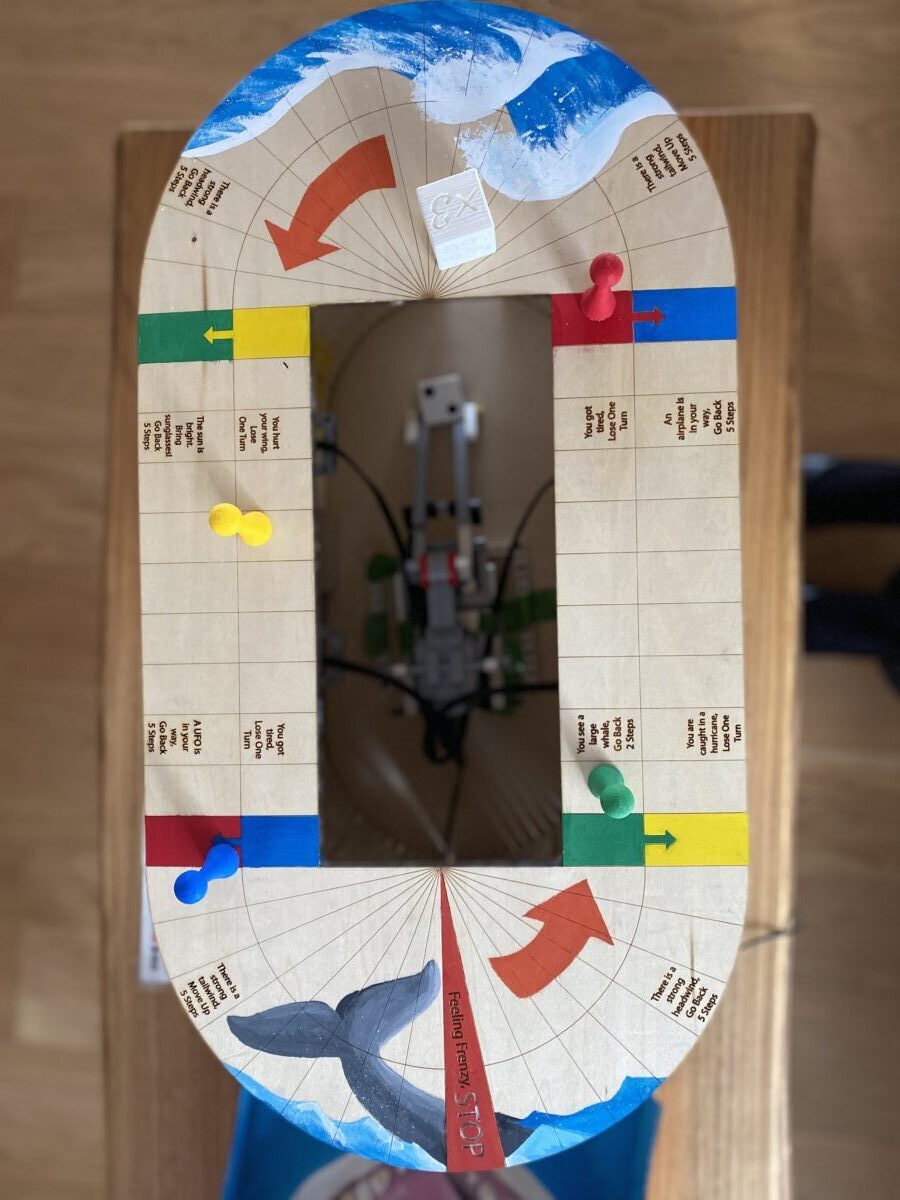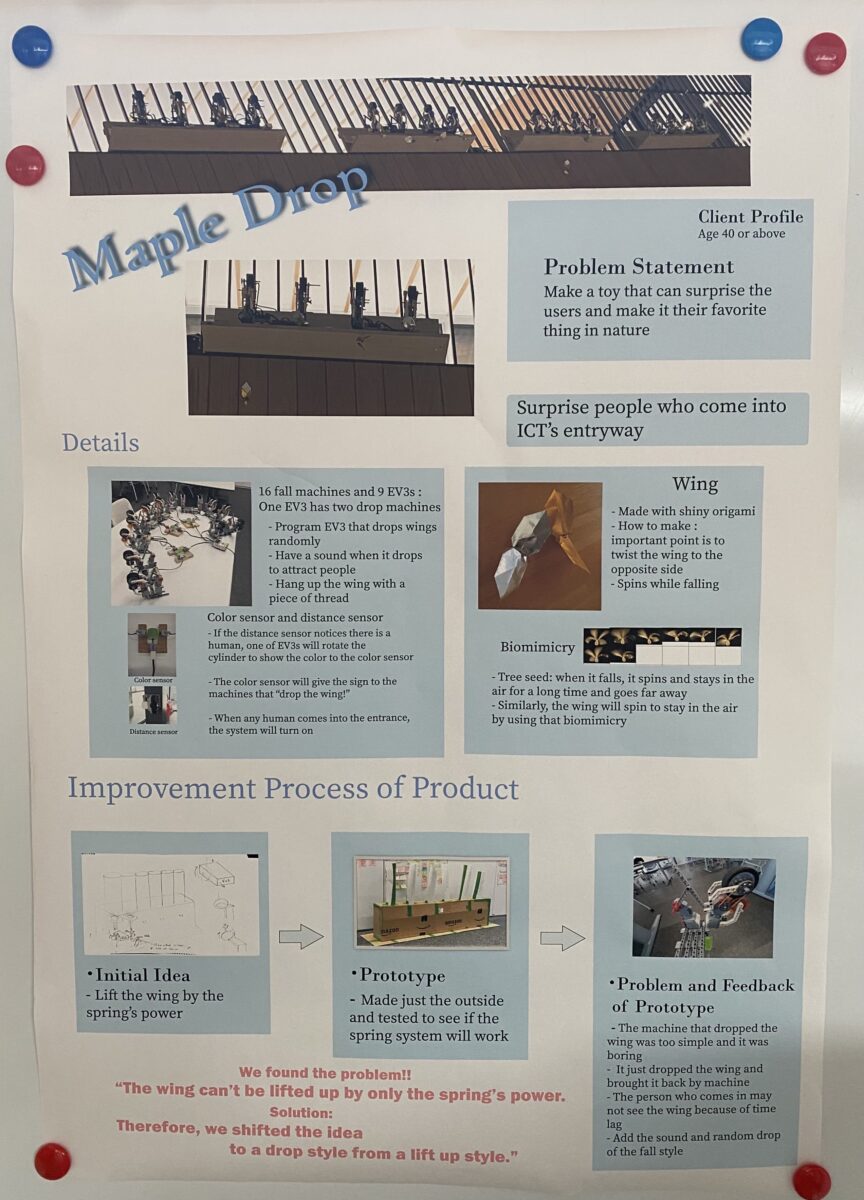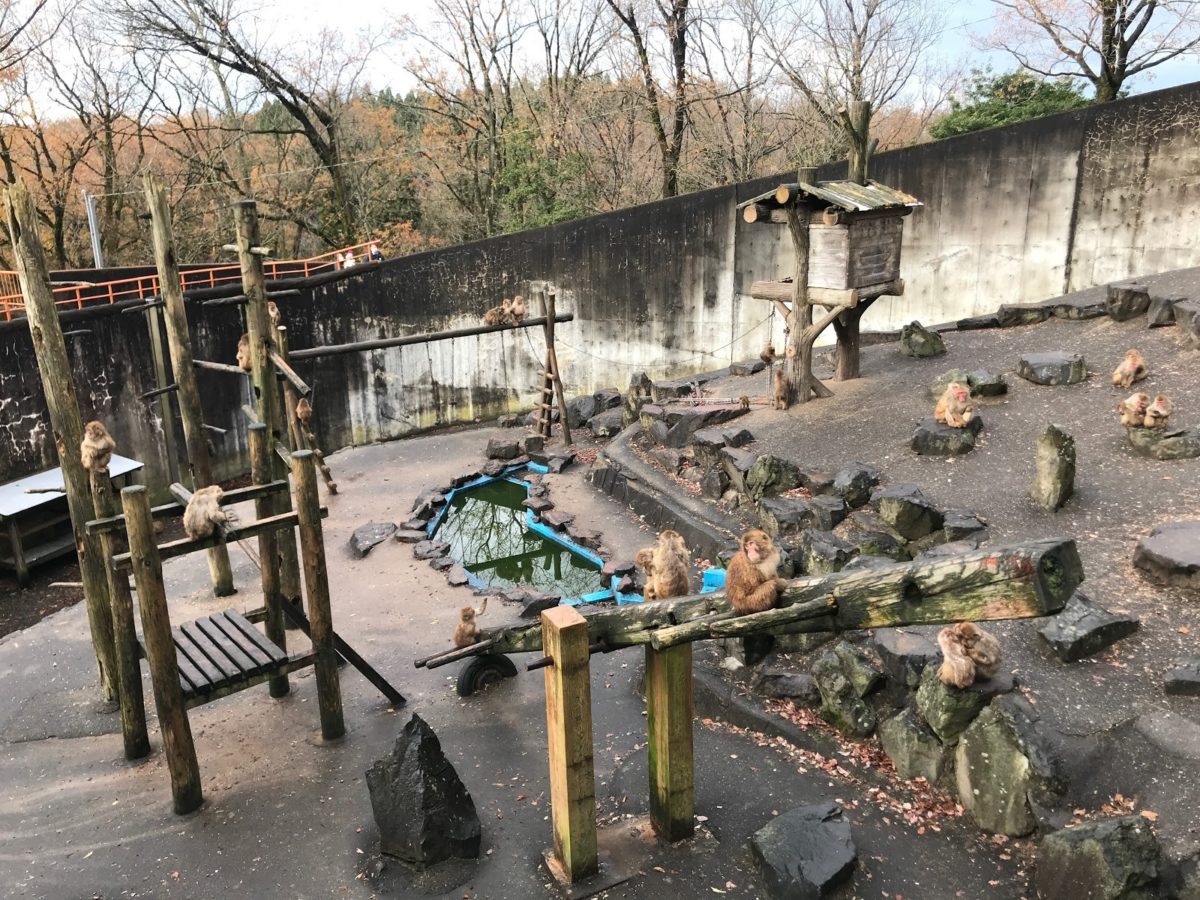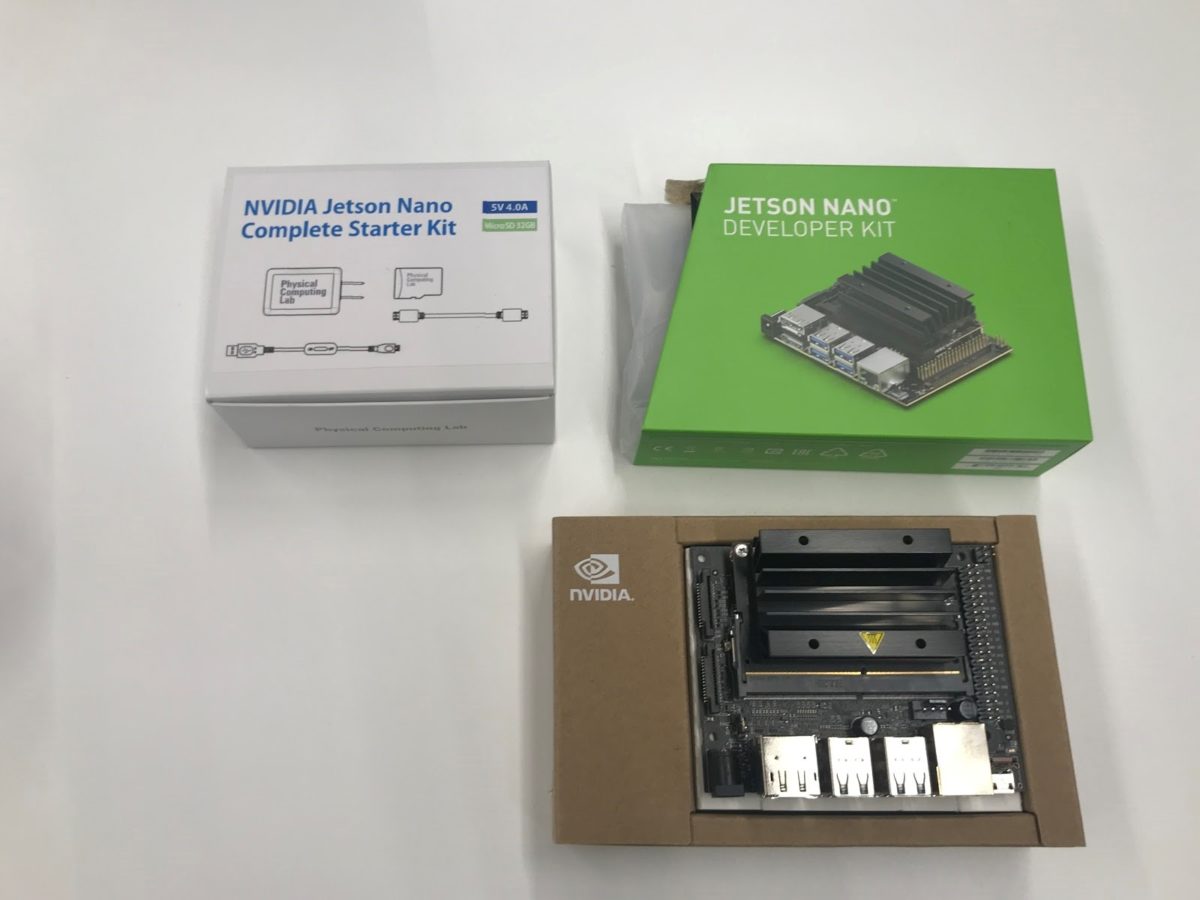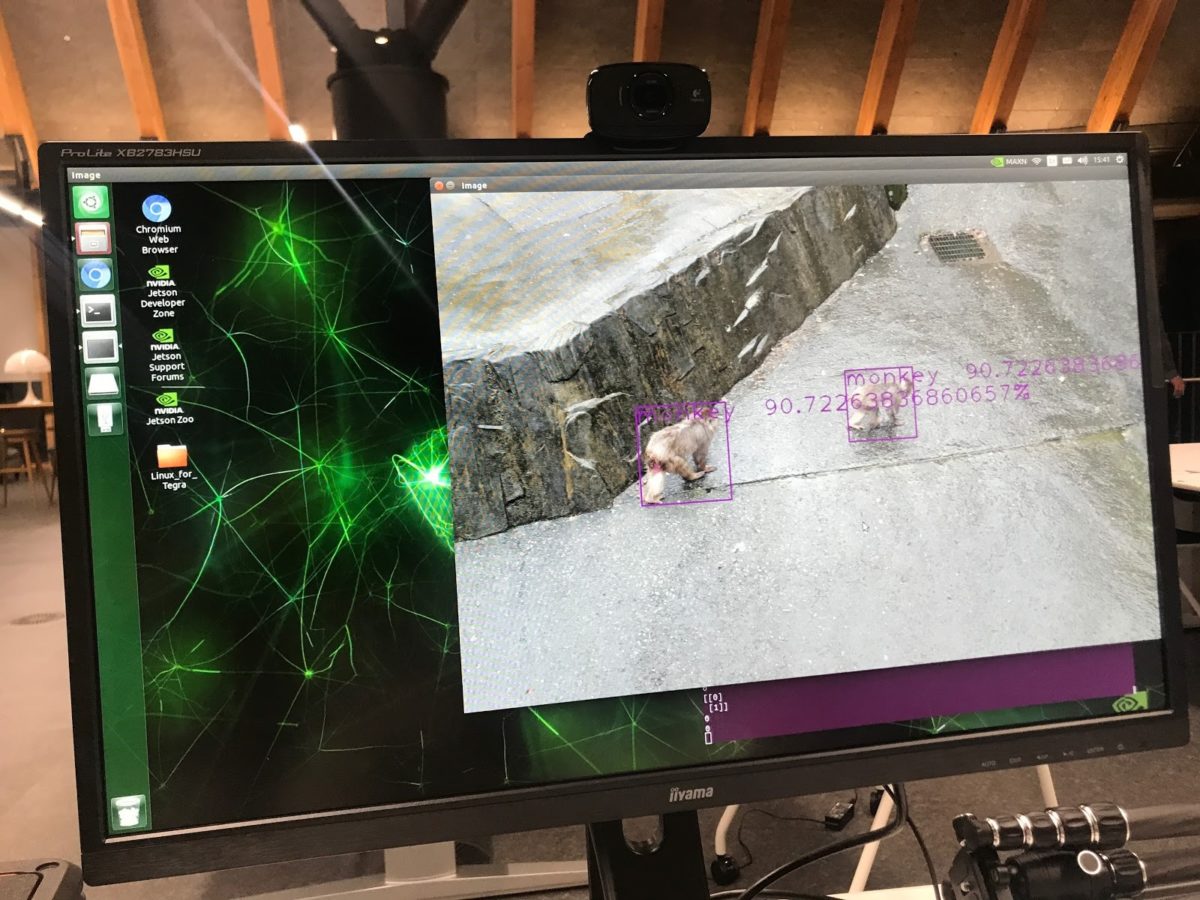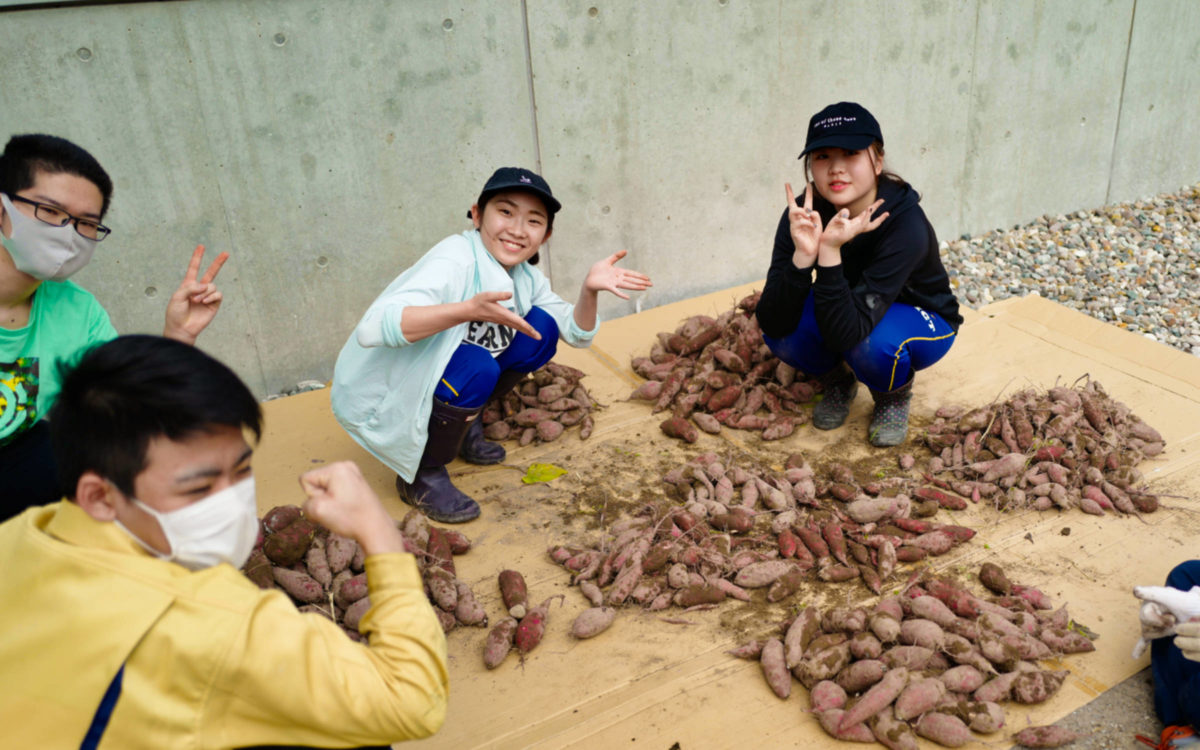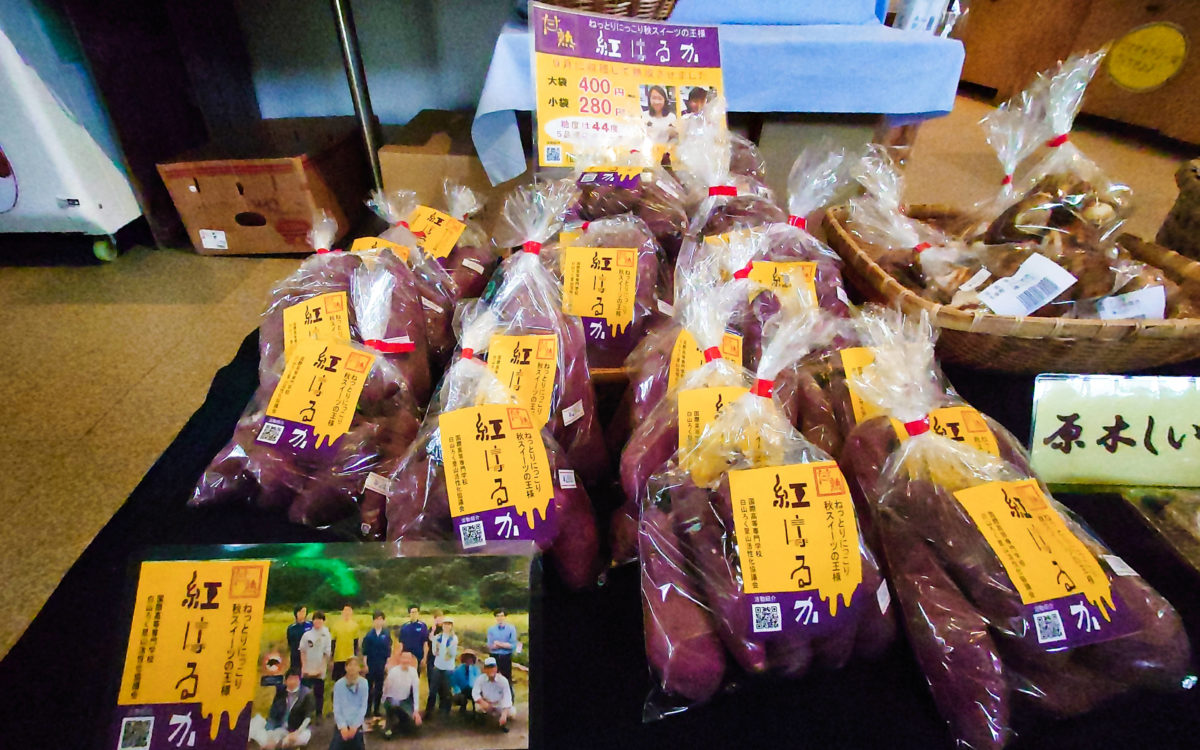Hakusanroku Journal 白山麓ジャーナル:Engineering Design (ED)
February 19, 2022 エンジニアリングデザインIB 最終発表
 こんにちは!白山麓高専事務室の間加田 侑里です。今回は1月28日に行われたエンジニアリングデザインIBの最終発表についてご紹介します。
こんにちは!白山麓高専事務室の間加田 侑里です。今回は1月28日に行われたエンジニアリングデザインIBの最終発表についてご紹介します。
1年生が履修するエンジニアリングデザインIBでは、ユーザー視点に立った新たな価値創出の手法である「デザインシンキング」を取り入れ、課題発見・解決型の活動にチームで取り組みます。その中でLEGO EV3、プログラミング、センサの使い方、ロボットの組み立て方などを学びます。
今回のプロジェクトでは、楽しませたり驚かせたりする「おもちゃ作り」が課題として与えられ、ターゲットとする年代別で2チームに分かれました。また、おもちゃには動物や植物などの特徴や機能など、生物が持つ「仕組み」を取り入れることが条件でした。
各チームは作品作りのため、教員に「普段の生活の中でどのような楽しみや驚きを感じることがあるのか」についてインタビューしました。
Hello! This is Yuri Makada from the Hakusanroku office. This time, I would like to write about the first-year students and their Engineering Design IB final presentation on January 28th.
In Engineering Design IB, teams work together to discover and solve problems using design thinking, a method of creating new value based on user perspective. In this course, students learn about LEGO EV3, programming, how to use sensors, and how to assemble robots.
For this project, the task was to make toys that would be entertaining and surprising. The students were divided into two teams according to their target age groups. In addition, the toys were required to incorporate the mechanisms of living things, such as the features and functions of animals and plants.
In order to create their toys, each team interviewed teachers and asked them "What do you enjoy or feel surprised about in your daily life?"
ORCA GAME
このチームは30代以下の教員にインタビューを実施し、「競争したり、達成感を感じたり、あることに熱中したりする中で楽しみを感じる」という意見をヒントにしました。そこでゴールまでを競い合い、ゴールの達成感を味わうおもちゃとしてボ-ドゲームに着目し、夢中になる要素にサイコロを振る装置を取り入れることにしました。LEGO EV3で作られたサイコロを振る装置は、シャチが水中に泳いでいる魚を尻尾で蹴り上げる動作を現したものです。サイコロを振る装置はランダムで飛距離が変わり、コマに当たり倒れる可能性があります。これはシャチが蹴り上げて飛ばした魚が鳥に衝突する場面を表現し、これによってコマが落ちてしまうかもしれないというヒヤヒヤ感を味わうことができます。
This team interviewed teachers younger than 30 years old and took their cue from their comments about elements of competition, a sense of accomplishment, and enthusiasm for certain things. They focused on a board game designed for players to compete to reach the final goal and feel a sense of accomplishment. Also they decided to incorporate the element of uncertainty into the dice rolling device. The dice rolling device made of LEGO EV3 represents the action of an orca flicking a fish into the air with its tail. The dice rolling device randomly changes how hard the dice is rolled and as a result the dice game token may be knocked over. This represents a scene where a fish flicked up by an orca collides with a bird. Players can feel a sense of dread that the game token might drop.

Maple Drop
このチームは40代以上の教員にインタビューを実施し、「自然との関わり」に興味がある方が多いと気づきました。このことから、普段の何気ない行動の中で「自然」に関するものに接して「アラっ?」というような穏やかな驚きをもらえるようなおもちゃを制作することにしました。玄関にセンサを設置し、人が通ると、ヒラヒラと葉っぱが落ちてくるような装置をLEGO EV3で制作しました。葉っぱはメイプルの種の構造を参考に折り紙で制作し、綺麗な様子によって驚きを与えるという素敵な装置です。それらの装置を12台も制作しましたが、残念ながら最終発表では3台しか動作しませんでした。
This team conducted interviews with teachers over 40 years old and noticed that many of them were interested in relationship with nature. This led them to the idea of creating toys that would give them a mild surprise like "eh?" when they came into contact with something related to nature in their daily activities. They set up a sensor at the school entrance and created a device with LEGO EV3 that made leaves flutter and fall when people walked by. The leaves were made of origami paper, based on the structure of maple leaves, and it was a wonderful device to surprise the audience with its beautiful appearance. They made 12 of these devices, but unfortunately, only 3 of them worked in the final presentation.
学生たちは、作品を完成させるために、放課後の時間も費やし、動作の確認やデザインレビューセッションを何度も繰り返し、改善点を抽出するなど、チームで思考錯誤しながら作品を懸命に作り上げました。それでも最終発表本番では、トラブルも発生し、その対応に追われる様子もありました。しかし、学生たちは熱心に取り組んだからこそ今回の体験を通して得たものがあったように感じます。
In order to complete their work, the students spent their time after school checking the operation, repeating the design review session many times, and extracting points for improvement. They worked hard to create their work through trial and error as a team. Even so, there were some problems that arose during the final presentation, and the team was forced to deal with them. However, I feel that the students gained a lot from this experience because they worked so hard.
October 18, 2021 紅はるか収穫
地域活性化に向け農業法人経営を実践するビジネス班と獣害対策に取り組むテック班。
11月3日(水・祝)のオンライン進学説明会では学生自らが取り組みを紹介
 国際高専では2年生が問題発見・解決型のプロジェクト授業「エンジニアリングデザイン」の一環で「Agriculture Innovation Project」に取り組んでいる。白山麓における中山間地域における少子高齢化や耕作放棄地、獣害の増加などの課題に向き合い、その課題解決に向けて取り組む授業で、学生は、校舎前の休耕田を使ってサツマイモ「紅はるか」の生産を行い、営業、販売、決算までさながら「農業法人」の経営ビジネスを体験していく「ビジネス班」と、AIやIoTを用いて獣害対策システムの開発に取り組む「アグリテック班」に分かれ、通年で活動している。
国際高専では2年生が問題発見・解決型のプロジェクト授業「エンジニアリングデザイン」の一環で「Agriculture Innovation Project」に取り組んでいる。白山麓における中山間地域における少子高齢化や耕作放棄地、獣害の増加などの課題に向き合い、その課題解決に向けて取り組む授業で、学生は、校舎前の休耕田を使ってサツマイモ「紅はるか」の生産を行い、営業、販売、決算までさながら「農業法人」の経営ビジネスを体験していく「ビジネス班」と、AIやIoTを用いて獣害対策システムの開発に取り組む「アグリテック班」に分かれ、通年で活動している。
10月4日(月)、さわやかな秋空のもと、ビジネス班が紅はるかの収穫作業を行った。
今年はサルが畑に侵入するのを防ぐ電気柵をより強力にしたため、獣害が無かったことと、こまめに雑草を除去し、芋を太らせるための「つる返し」の作業も行ったことが奏効して、昨年の1.9倍となる190kgの収穫ができた。
収穫した紅はるかは、校舎内の倉庫で約1か月間、熟成させ、デンプンを糖分に変えた後、10月30日(土)より校舎前の道の駅瀬女で店頭販売を行う。11月3日(水・祝)に開催する国際高専オンライン進学説明会では、道の駅瀬女から中継を行い、ビジネス班とアグリテック班が取り組みについて説明する予定だ。
国際高専オンライン進学説明会の詳細はこちら
https://www.ict-kanazawa.ac.jp/onlinesession/
志鷹 英男
The Business Group manages an agricultural corporation to revitalize the region, and the Tech Group is working on animal damage prevention. The students themselves will introduce their efforts at an online information session on Wednesday, November 3.
At the International College of Technology (ICT), second-year students are working on the " Agriculture Innovation Project" as part of the "Engineering Design" project class, based on problem finding and solving. In this class, the students use the fallow rice fields in front of the school building to produce sweet potatoes, "Beniharuka," and experience the management business of an "agricultural corporation," including sales, marketing, and settlement of accounts. The group is divided into the "Business Group," which produces sweet potatoes, "Beniharuka," using fallow rice fields in front of the farm, and the "Agritech Group," which works on the development of animal damage prevention systems using AI and IoT.
On Monday, October 4, the Business Team harvested sweet potatoes under a crisp autumn sky.
This year, the electric fence was made more robust to prevent monkeys from entering the field, so there was no animal damage. The team also removed weeds frequently and did "vine turning" to fatten up the potatoes, which helped them harvest 190 kg, 1.9 times more than last year.
The harvested Beniharuka potatoes will be matured in the school's warehouse for about a month to convert starch into sugar. They will be sold at the Roadside Station, Sena, in front of the school from Saturday, October 30.
In the online briefing session of the International College of Technology (ICT) to be held on Wednesday, November 3, the Business Team and Agri-Tech Team will explain their activities via live broadcast from Roadside Station Sena.
For more information about the online briefing session, click here.
https://www.ict-kanazawa.ac.jp/onlinesession/
Hideo Shitaka
July 10, 2021
 国際理工学科2年の山崎史依です。先月、エンジニアリングデザインの授業の一環として山立会さんにお邪魔し、代表の有本さんのご講話を聞いた後に、羊の毛刈りを体験させていただきました。私が有本さんのお話しで一番印象に残った点は、「なぜ山立会で羊を飼おうと思ったのか」というチャプターでした。私は16年間石川で暮らしていて、石川の魅力を感じたことがありませんでしたし、どうすれば石川県というブランドとして成長できるかも考えませんでした。しかし、有本さんは「特産の肉が無い」・「白山麓に遊べる場所が無い」・「獣害や雪が関係ない」と提示していました。私はそれを聞いて、今までの石川県がやってきたようなすでにある名産品や伝統の押し売りとは違う全く新しく県外の観光客が共感できるアイデアだと感じ、感動しました。
国際理工学科2年の山崎史依です。先月、エンジニアリングデザインの授業の一環として山立会さんにお邪魔し、代表の有本さんのご講話を聞いた後に、羊の毛刈りを体験させていただきました。私が有本さんのお話しで一番印象に残った点は、「なぜ山立会で羊を飼おうと思ったのか」というチャプターでした。私は16年間石川で暮らしていて、石川の魅力を感じたことがありませんでしたし、どうすれば石川県というブランドとして成長できるかも考えませんでした。しかし、有本さんは「特産の肉が無い」・「白山麓に遊べる場所が無い」・「獣害や雪が関係ない」と提示していました。私はそれを聞いて、今までの石川県がやってきたようなすでにある名産品や伝統の押し売りとは違う全く新しく県外の観光客が共感できるアイデアだと感じ、感動しました。
また、有本さんが言っていたようにブランド化するにはアニマルウェルフェアなどのステータスだけでなく、デザインやロゴ、コンセプトが重要という点にも深く共感しました。それに対するアファフさんの提案にも、とっても需要があると思いました。
羊の毛刈りでは、見ているだけだと簡単そうでしたが、実際にやってみるとバリカンが重いうえに振動が自分に伝わってすごく難しかったです。だけど、何度もやって自信をつけるとするすると毛が刈れてとっても気持ちがよかったです。また、やっていくうちにもっとうまくなりたいと思ったり、羊に対しての愛情が生まれました。また機会があれば挑戦したいです。
山崎史依
Hello, I'm Shii Yamazaki, a second-year student of the Department of Science and Technology. Last month, we visited Yamadachi-kai as part of the Engineering Design class. We listened to Arimoto CEO's lecture and experienced sheep shearing. The thing I remember the most from Arimoto-san's lecture was why he decided to start Yamadachi-kai's sheep business. I have lived in Ishikawa for sixteen years, but I never thought about its good points or how the Ichikawa brand could grow. However, Arimoto-san gave the reasons "Ishikawa has no special livestock", "there is no place to play in Hakusanroku", and "sheep are unaffected by wild animals and snow." Hearing this, I realized that it was different from any other local speciality or tradition in Ishikawa prefecture has tried or forced on to tourists. I felt like it is a new perspective that tourists can relate to.
Also as Arimoto-san said, not only are statuses such as animal welfare important to create a new brand, but also design, logo, and concept. I believe the suggestions that Afaf proposed have a lot of demand too.
The sheep shearing looked easy at first, but was actually very difficult because the clipper was heavy and the vibration transmitted to me. However, it felt good when I could smoothly shear the wool off the sheep after I had a lot of practice and got used to it. Also, I fell in love with the sheep and wanted to be become better at it. I want to try again in the future.
Shii Yamazaki
June 23, 2021 Report from Hakusanroku (June)
 ジョナサンです!6月の白山麓キャンパスは気温も上がり、汗ばむ季節になってきました。国際高専1、2年生は校舎の内外で様々な活動に励んでいます。最近あったイベントを3つ、レポートします。
ジョナサンです!6月の白山麓キャンパスは気温も上がり、汗ばむ季節になってきました。国際高専1、2年生は校舎の内外で様々な活動に励んでいます。最近あったイベントを3つ、レポートします。
6月1日(火)、エンジニアリングデザインIIAのアグリテック班がMRO北陸放送の取材を受けました。2年生のエンジニアリングデザインでは地域の課題解決を行っており、アグリテック班は前年のプロジェクトを引き継いで、AIによる獣害対策システムを製作しています。今年の2年生の目標はAIが認識した猿を追い払うシステムの実装で、取材の中では白山麓キャンパスと道路を挟んだ向かいの休耕田で地元の方に猿被害の規模や望ましい撃退方法の聞き取りをするシーンや、目指すゴールについて語るシーンが撮影されました。この内容は6月9日(水)の「レオスタ」で放送されました。本プロジェクトは昨年度に一般社団法人電気学会「U-21学生研究発表会」で最優秀賞を受賞しており、その後の成果に注目が集まっています。
6月3日(木)、エンジニアリングデザインIIAのアグリビジネス班の2年生4名が白山麓キャンパスから近い木滑地区でひつじの放牧を行っている山立会にお邪魔して、会社見学とひつじの毛刈り体験をしました。アグリビジネス班は白山麓ブランドのさつまいも「高専べにはるか」の生産・販売プロジェクトを行っており、同じく新規事業立ち上げをした山立会から農業経営のノウハウを学ぶために科目担当の山崎先生がセッティングを行いました。
山立会のひつじ事業は石川県立大学の石田名誉教授の「耕作放棄地放牧で生産されたラム肉の地産地消による地域活性化の課題研究」を引き継ぐ形で誕生したビジネスです。代表の有本勲氏は白山麓特産の肉がないこと、昼間に観光客が遊ぶ場所がないこと、獣害や豪雪の影響を受けないことなどからラム肉に可能性を感じて、事業展開に踏み切りました。有本さんが学生にしてくれたプレゼンではひつじ飼育の出産から出荷までの年間スケジュール、収支計画、5年後に収益500万円を目指す長期目標、必要な畜舎や機械などの設備などを解説し、そのための資金調達で行ったクラウドファンディング、補助金申請、付加価値によるラム肉の単価アップなどを紹介しました。また、ひつじ餌やり体験、毛刈り体験、BBQ用ラム肉販売によって白山麓地域の観光を盛り上げていきたい旨を語りました。学生は簡単に儲からないとわかっていながら様々なチャレンジをする有本さんの話をメモを取りながら真剣に聞いていました。また、プレゼンのあとには10分間の質疑応答の時間があり、熱心な学生が熱心に質問や提案をしていました。
毛刈り体験をした学生は「見ているだけだと簡単そうでしたが、バリカンが重いうえに振動が伝わって難しかった」「何度もやってするすると毛が刈れたときは気持ちよかった」「羊に対して愛情が生まれました」と語っていました。
6月20日(日)、ネイチャー&アドベンチャークラブが鷲走ヶ岳へハイキングに出かけました。鷲走ヶ岳は1,097mの山で、白山麓キャンパスから車で10分ほどのところに登山口があります。メンバーは1、2年生5名、山崎先生、潟辺先生、フィリップ先生、尾張コーチ、私の計10名でした。コースの大部分は森林の中を通っていくため、涼しい日陰に守られて快調に進みました。休憩時には尾張コーチが柑橘系の香りがする「クロモジ」、樹皮が熊によって剝がされた木、コアジサイの花など、山の見どころを解説しました。白山麓キャンパスを出発したのは8時半で、山頂へ到着したのは11時15分頃でした。晴れていれば白山が望める場所ですが、この日は雲がかかっていて見えませんでした。早い昼食を食べたあと、白抜山という隣にある891mの山へ登ってから下山しました。学生たちは元気いっぱいで、山道を走ったり、休憩時に木に登ったりして、有り余る体力を存分に発揮していました。来月には白山登山を控えている同クラブメンバーにとって、良い体慣らしとなったようです。
ジョナサン
Hi, it's Jonathan, the cameraman. June has brought warm weather to Hakusanroku and I see more and more people wearing t-shirts as summer approaches. Here are three events that happened in the past month.
On June 1 (Tue), The Agri-tech team was interviewed by MRO Hokuriku Broadcasting during Engineering Design IIA class. The Agri-tech team has succeeded last year's project, and is creating a system to protect crops from wild monkeys using AI. This year's second year students aim to implement a function to drive away monkeys detected by the system. The television crew filmed scenes of the students asking local farmers about the magnitude of damage on their crops and what they think is the best method to drive monkeys away, and scenes of them explaining their goals of the year. The program was broadcasted on "Leosuta" on June 9 (Wed). Last year's Agri-tech team won the highest award of the "U-21 Institute of Electrical Engineers of Japan" and the level of attention on this project is growing.
On June 3 (Thu), four second year students of the Agri-business teams visited Yamadachikai, which has lately begun herding sheep in Kinameri district near Hakusanroku Campus. The Agri-business team is growing and selling local branded sweet potatoes "Kosen Beni Haruka" and Yamazaki sensei organized this visit to listen to the representative of Yamadachikai talk about his experience staring a agricultural business in Hakusanroku.
Yamadachikai's sheep business began when they were approached by the team of Ishida professor of Ishikawa Prefectural University who was doing research on the possibility of a sustainable business model selling lamb meat herded and sold in the local area. Arimoto-san, the representative of Yamadachikai, accepted this offer after agreeing that Hakusanroku lacked local branded livestock and daytime activities for tourists. Also, sheep are unaffected by the harsh winter season and wild animals in the area, which are difficulties of other products. In the presentation he gave to the students, Arimoto-san explained the annual schedule of selling lamb meat, the company's table of income and expenditure, their long-term goal of a profit of 5 million yen in five years, the necessary facilities they plan to purchase, etc. To accomplish this, Arimoto-san has utilized crowdfunding, applied for financial support from the government, and tried multiple methods to increase the price of their meat. He also plans to contribute to the local tourist scene by letting people feed and shear the sheep, and selling BBQ meat to campers. Arimoto-san understood that making a profit with sheep wasn't going to be easy in Hakusanroku, but he took on the challenge and came up with ideas to create a successful business. The second year students listened intently and took notes. There also was a QA session after the lecture that lasted ten minutes as Arimoto-san and students exchanged ideas.
After the lecture, students tried out shearing the sheep. Later, they commented "It looked easy at first but the electric clipper was heavy and difficult to keep steady due to the vibration, but once I got used to it, it felt good as the wool came off" and "I grew fond of the sheep."
On June 20 (Sun), the Nature & Adventure Club went hiking at Mt. Wasso-ga-take, which is a mountain of an altitude of 1,097 meters with a hiking course about ten minutes by car from Hakusanroku Campus. Participants were five club members, Yamazaki sensei, Katabe sensei, Philip sensei, Owari coach, and myself; a total of ten people. Most of the hiking course is through the forest, which shaded us from the hot sun. During breaks, Owari coach showed us wild herbs such as "Kuromoji", trees that bears had peeled the bark off, and flowers such as koajisai (Hydrangea hirta). We left Hakusanroku Campus at 8:30 am and reached the top of Wasso-ga-take around 11:15. Usually you can see Mt. Hakusan from this point. However, sadly it was hidden by low clouds. We ate an early lunch and headed to a neighboring mountain called Shironuki-yama (891m) before descending back down the trail. Students were full of energy and sometimes ran down the path or climbed trees along the way. Next month, they plan to climb Mt. Hakusan itself so this hike was a nice warm up ahead of time.
Jonathan
June 16, 2021
 Hello everyone! Summer is almost in full swing here at the Hakusanroku Campus. Something else that is in full swing around here, is the S1 students’ “worst design” project for Engineering Design 1A. For this project, the students are tasked with taking something that they use every day, that causes them some sort of problem or inconvenience, and design a way to improve its function. This year, there are all sorts of projects, there are different fixtures to be attached in the student’s bedrooms and even redesigning school supplies used in other classes. It is so interesting to see what the students view as the worst thing they use every day, because it gives insight into their personalities and life styles.
Hello everyone! Summer is almost in full swing here at the Hakusanroku Campus. Something else that is in full swing around here, is the S1 students’ “worst design” project for Engineering Design 1A. For this project, the students are tasked with taking something that they use every day, that causes them some sort of problem or inconvenience, and design a way to improve its function. This year, there are all sorts of projects, there are different fixtures to be attached in the student’s bedrooms and even redesigning school supplies used in other classes. It is so interesting to see what the students view as the worst thing they use every day, because it gives insight into their personalities and life styles.
This past week, the students started working on their rough prototypes. The goal of these prototypes, is to help the students visualize their product in order to figure out areas that still could use some improvement. The students built these models out of common materials like paper, cardboard, or foam. It was wonderful to see the students work so hard and to see their ideas begin to take shape. Jonathan, the camera man, was able to get some really nice pictures of the students building their rough prototypes. These protypes do not need to work perfectly, they are more of a way to determine if the size and shape truly works for what the student is intending it to be used for. Once they have completed this prototype they will them begin to build the first iteration of their final product using different materials they have requested. I am excited to see how their first iterations will turn out, and based on the rough prototypes they just made, I think there will be some unique and interesting final products.
-Brandon
みなさん、こんにちは!白山麓キャンパスはまもなく暑い夏を迎えようとしています。さらにもうひとつ、アツいものと言えば、S1学生のエンジニアリングデザイン1Aの「最悪のデザイン」プロジェクトです。学生に課されたお題は、毎日使うもので問題や不便を引き起こしているものを見つけて、機能を改良するデザインを施すことです。学生たちが出したアイデアは様々です。自室に取り付けるものもあれば、ほかの授業で使う道具をリデザインするものもあります。学生が毎日使うもので、何を最悪と思うのかを観察することで、その学生の性格や生活習慣が見えてくるのでとても面白いです。
先週、学生たちはラフ・プロトタイプ作りを開始しました。ラフ・プロトタイプは一度視覚化することで、さらなる改善点を探すことが目的です。材料は紙、段ボール、発泡スチロールなどの簡易的なものです。学生たちが努力をしてアイデアを形にしていく様は見ていて嬉しくなりました。カメラマンのジョナサンが、ラフ・プロトタイプ制作中の写真を撮ってくれました。このプロトタイプは完璧に機能する必要はなく、どちらかというと大きさや形が学生の想定している通りかを確認するためのものです。これが完了したら、次は実際の材料を使って本製品第一号に取り掛かります。ラフ・プロトタイプを見ているだけに、どんなものが完成するのかがとても楽しみです。非常にユニークで面白いものが期待できますよ。
―ブランドン
May 19, 2021 Activities in May
 Hello, it's Jonathan, the camera man! April has turned into May, and the weather is almost perfect here at the Hakusanroku Campus. I have gathered pictures of the first and second year students and some of their major activities in the past weeks. Enjoy!
Hello, it's Jonathan, the camera man! April has turned into May, and the weather is almost perfect here at the Hakusanroku Campus. I have gathered pictures of the first and second year students and some of their major activities in the past weeks. Enjoy!
こんにちは、カメラマンのジョナサンです!5月に入って、白山麓キャンパスの気温は暑くも寒くもなく、とても過ごしやすいです。今月に入ってから白山麓キャンパスで行われた活動の写真をいくつか載せたいと思います。ぜひご覧ください!
Sports Day
On May 1, the two PE teachers, Takimoto sensei and Philip sensei held a sports event in the gym. Students were not able to return home during the Golden Week holidays, and many events such as this were created to make the days as enjoyable as possible. This time, the sports were badminton and volleyball. In the badminton portion, Philip sensei introduced a new level system. All students start at level one. You level up by defeating someone in your same level or higher, to a max level of four. You can play as many games as you like with anyone you choose. This system seemed to suit the students and the three courts were constantly occupied by players challenging each other. The volleyball portion were games between the students and teachers. I apologize for not taking any pictures of the volleyball portion because I was playing the whole time.
5月1日(土)は保健体育の瀧本先生とフィリップ先生が企画したスポーツデイが体育館で行われました。今年の1,2年生はゴールデンウイーク中に帰省できませんでしたので、代わりに先生や学生が休日を楽しめるように様々なイベントを企画しました。このスポーツデイもそのひとつです。今回の種目はバドミントンとバレーボールでした。バドミントンでは、フィリップ先生が新たな「レベルシステム」を導入しました。このやり方では、参加者全員がレベル1からスタートします。その後、自分と同じか上のレベルの人と対戦して勝利するとレベルがひとつ上がります。制限時間内であれば誰と何回対戦するかは自由です。最高レベルは4で、制限時間内にどこまでレベルアップできるかを競います。この新しいシステムは学生たちに好評のようで、3つのコートは常に楽しそうな学生で埋まっていました。バレーボールの時間では学生と教職員のオールスターチーム同士が対戦しました。私は教職員チームに参加していたため、残念ながら写真はありません。
Camping Indoors
On May 2, the Nature & Adventure Club used the whole day to craft, hike, camp, and do all sorts of outdoor stuff. Sadly, the weather forecast was rainy but the club members improvised and enjoyed their first club activity anyway. They did ropework, bamboo crafting, and ate curry and rice for lunch at KTB sensei's house. In the afternoon, they went hiking near Dainichi dam in Torigoe before returning to ICT. Originally, they planned to camp outside on school grounds. However, the rain and wind was too strong and they made the brave choice to camp in the second floor of the gym. Jokes aside, this turned out to be not a bad decision and they spent the evening chatting, listening to KTB sensei's guitar, and playing cards by a digital campfire. (How ICT is that!) One member wrote a journal entry about his experience which you can read here. (Coming soon)
5月2日(日)、ネイチャー&アドベンチャークラブが様々な活動を丸一日かけて行いました。天候は残念ながら雨でしたが、メンバーは予定を修正しながらもアウトドアをエンジョイしました。午前中はロープワークや竹細工体験を行い、その後、潟辺先生の自宅でおいしいカレーをいただきました。午後は鳥越にある大日ダム見学のハイキングツアーを行いました。本来はキャンパス敷地内にテントを張ってキャンプをする予定でしたが、あまりにも雨風がひどかったため、代わりに体育館の2階部分に拠点を移動する英断を下しました。これが意外とグッドアイデアで、良い雰囲気の中、潟辺先生のギターを聴きながらハンモックでくつろいだり、タブレットに映したデジタルのキャンプファイヤーを囲んでトランプで遊んだりして、夜を楽しみました。メンバーのひとりがこの日の活動についてジャーナルを書きましたので、ぜひ読んでみてください。(近日公開)
Original T-shirt Design
On May 3, Ito sensei and Kodaka sensei organized an event to make original design t-shirts. Students used their computers to design and print out the design. Then, they ironed on the transfer paper to the front or back of the t-shirts. Students could choose one black or white t-shirt to design. Some students who had a clear vision finished before lunch. However, others took longer to come up with a design or had trouble transferring the design they chose. In the end, it was an exciting experience and many students voiced their joy in their finished product.
5月3日(月)は、伊藤先生と小髙先生が企画したオリジナルデザインのTシャツを作るイベントが実施されました。学生はパソコンソフトを使って好きなデザインを作り、Tシャツの表か裏にアイロンで転写しました。参加した学生はそれぞれ白か黒のTシャツをひとつ選ぶことができました。すぐにデザインが決まって早く完成した学生は昼食前に終わりましたが、デザインを考えることに時間をかけたり、凝ったデザイン故にアイロンがけに時間がかかったりした学生もいました。完成したTシャツを見て「おおー!」「きれいー!」と声を上げる学生も多く、刺激的な活動になりました。
Engineering Design II A: Plowing with a Tractor
Returning to school, the agri-business team of the second year's Engineering Design class began working in the fields across the street from ICT. This team's goal is to grow sweet potatoes and make a profitable business model selling them. On May 6, they were joined by members of the local community who lent and taught the students how to drive a tractor. Each student took turns using the tractor to plow the plot of land they will use to plant the sweet potatoes. Unsurprisingly, it was the first time for the students to drive a tractor, and they enjoyed the experience as you can see in the pictures and video below.
授業が再開した5月6日(木)、2年生のエンジニアリングデザインのアグリビジネスチームが畑仕事を開始しました。アグリビジネスチームは地元ブランドのさつまいもを栽培・販売して、ビジネスプランの成功を目指します。この日の活動は白山麓キャンパスの向かいにある畑を耕す作業で、地元の方にトラクターを貸していただき、運転を教えてもらいました。学生たちは順番にトラクターに乗りながら、畑を耕していきました。もちろん、全員トラクターに乗るのは初めてで、写真とビデオの表情からも楽しんでいる様子がわかると思います。
Tie-Dye T-shirts
The last activity I would like to show you is the tie-dye t-shirt event, held after school on May 12 by the Language and Culture Club, for all first and second year students. Tie-dye is a method of folding, twisting, or crumpling fabric, and applying dye to create unique patterns. Ian sensei and Pauline sensei provided various colors of dye, t-shirts, rubber bands, gloves, aprons, and bleach for those who wished to dye a black t-shirt. The students quickly began choosing colors and methods to design their t-shirt. The instruction manual that came with the dye listed several techniques, and some students even experimented with original ways to use the dye; some improvised with their fingers, makeshift brushes, and pipes. You can see their finished products in the pictures below.
最後に紹介するのは5月12日(水)にランゲージ&カルチャークラブ主催で行われた1,2年生の希望者のためのタイダイTシャツ染め体験です。タイダイ染めは生地を折ったり、ねじったり、くちゃくちゃにしたりしてから固定して染料を加える手法で、独特の模様ができるユニークな染め方です。顧問のイアン先生とポーリン先生は様々な色の染料、Tシャツ、輪ゴム、ビニール手袋、エプロン、黒いTシャツに染めたい学生のための漂白剤を準備しました。付属のマニュアルには様々な手法が解説されており、学生たちは様々な色を組み合わせたり、指や筆やパイプどを使ってオリジナルデザインのTシャツを染め上げました。完成したTシャツは下の写真でご覧ください。
December 20, 2021 Engineering Design IIB Projects
 Hi it's Jonathan again! Today I would like to show you the videos of the second year students talking about their Engineering Design projects. As you saw in the previous entry, students at ICT learn to find problems in their surroundings and create solutions to resolve them. The first year students focus on the Hakusanroku Campus, and the second year students take it a step further by moving their attention to the local community. Hakusanroku is a rural area in Ishikawa prefecture with problems you would expect from a village away from major cities; aging and decreasing population to name a few. The students were divided into three groups, each with a different theme.
Hi it's Jonathan again! Today I would like to show you the videos of the second year students talking about their Engineering Design projects. As you saw in the previous entry, students at ICT learn to find problems in their surroundings and create solutions to resolve them. The first year students focus on the Hakusanroku Campus, and the second year students take it a step further by moving their attention to the local community. Hakusanroku is a rural area in Ishikawa prefecture with problems you would expect from a village away from major cities; aging and decreasing population to name a few. The students were divided into three groups, each with a different theme.
Agri-tech
The "Agri-tech" group focused on the growing problem of damage to crops by wild animals. Hakusanroku is home to wild boars, bears, and MANY monkeys. Locals try to protect their crops from them with electrical fences and fire crackers. However, this is becoming increasingly difficult as they grow older and fewer in number, and because monkeys quickly learn how to avoid their defenses. Seeing this, the Agri-tech group came up with a long term plan to create a automatic defense system against the animal forces. Their goal for this year was to create a system that can detect monkeys in the wild using AI. As you can see in their presentation, they took thousands of pictures of monkeys, which they "fed" to the AI until it could steadily achieved a recognition rate of 65~90%. Since monkey attacks to crops is a nation-wide problem and their are no current known projects working on this topic, this team may be the pioneers on solving a major issue all over Japan. You can read more details about their project here.
Agri-business
The "Agri-business" group turned their eyes to the decreasing population and shrinking economy. Hakusanroku is in a negative spiral, in which younger generations leave for larger cities which in turn leads to less demand and job opportunities for them. The group challenged themselves with designing and operating a business model of growing and selling Hakusanroku branded sweet potatoes. They planted, harvested, packaged and sold their sweet potatoes "Kanjyuku-Beni-Haruka". You can read more about their project here. In their presentation, they went into more detail on how much money they made (or lost) and what changes are necessary to actually create a sustainable business model in Hakusanroku.
Nigyo-Jyoruri
Nigyo-Jyorui is a traditional puppet show dating back more that 300 years ago. The people of Higashi-futakuchi district have continued to preform it every year. However, their numbers are also dwindling and they have few young performers that serve as potential successors. You can read about the history of Ningyo-Jyoruri in this article. The group was limited on what they could actually do due to COVID-19, especially because this year's performance was canceled. In there presentation, they explained that after exhausting ideas such as collaborating with popular anime or creating online videos to spread the culture, they finally decided to appeal to the local children of Hakurei Elementary and Junior High School by hosting a doll making event at ICT. In the event, kids could use a 3D scanner and 3D printer to create Nigyo-Jyoruri dolls using their own scanned faces. Potentially, this would benefit both sides by introducing kids to ICT's technology and Ningyo-Jyoruri culture.
This final presentation was a great display of how much the second year students have grown. All their hard work has paid off by increasing not only their technological skills, but teamwork, time management, presentation skills, and English skills.
Jonathan
You can see their presentations in the videos below. (The first two are in Japanese and last one is in English)
こんにちは、ジョナサンです!今日は2年生のエンジニアリングデザインの最終発表の様子を動画でお見せしたいと思います。その前に2年生のエンジニアリングデザインのプロジェクトについて。前回の記事でも書いたように、国際高専では身の回りにある課題を発見し、解決する授業がエンジニアリングデザインです。1年生はこの白山麓キャンパス、2年生は一歩進んで周辺地域の課題発見解決に臨みます。石川県の南に位置する白山麓は農村地特有の人口減少や若者の離脱などの課題を抱えています。学生たちは3つのグループに分かれてこれらの課題に取り組みました。
アグリテック班
アグリテック班は白山麓の獣害の問題に着目しました。白山麓では猿による農作物への被害が年々深刻化しています。地元住民は電気柵や花火などで対抗していますが、猿の学習能力の高さは脅威であり、住人の高齢化による体力減衰や人手不足の影響で劣勢を強いられています。これに対し、アグリテック班は獣害対策としてAIの力を借りようと考えました。長期的には自動で動物を発見し、畑から守ってくれるシステムを開発設置することが目標です。今年の2年生の目標はAIを使って猿を認識するシステムの開発でした。発表で学生は、猿の写真を何千枚もAIに「食べさせる」ことによって、65~90%もの高い認識率を達成できたと語りました。猿被害は全国的な問題で、このプロジェクトが成功すれば、日本初の自動猿撃退システムになる可能性を秘めています。アグリテックの活動についてもっと詳しく知りたい場合はこちらの記事をご覧ください。
アグリビジネス班
アグリビジネス班は人口減少と地元経済の関係に着目しました。白山麓は高齢化によって経済が後退し、それがさらなる若者の流失を招いている負のスパイラルに見舞われています。学生は白山麓で持続可能なビジネスモデルを確立することを目標に、白山麓ブランドのさつまいもを栽培・販売することに決めました。「甘熟紅はるか」と名付けられたさつまいもは学生たちが自ら種植え、草むしり、収穫、仕分け、ラベル作り、梱包、出荷をこなしました。このプロジェクトについてもっと知りたい場合はこちらの記事をご覧ください。発表の中で学生は収入と支出を述べ、継続的なビジネスモデルを形成するための条件を事細かに説明しました。
人形浄瑠璃
東二口地区で毎年行われている文弥人形浄瑠璃は300年以上の歴史がある伝統文芸です。しかし、最近では保存会会員も減り、後継者不足に悩まされています。人形浄瑠璃の歴史について詳しく知りたい方はこちらの記事をご覧ください。難しい課題な上、今年はコロナ禍の影響で公演が中止となってしまったため、活動範囲は限られてしまいました。発表の中で学生は人気アニメとのコラボレーションやインターネット動画サイトを使ったプロモーションなどのアイデア出しをするも実らず、視点を変えて後継者不足の課題に集中することを決めました。そのために国際高専の強みを活かして、地元の白嶺小中学校の子供たちを対象に人形作りイベントを開催することにしました。このイベントでは3Dスキャナーと3Dプリンターを使って子供たち自身の顔の人形を作ることができました。このイベントによって地元の子供たちが将来的には人形浄瑠璃の後継者を見つけるだけではなく、国際高専で学べる工学にも興味を持ってもらおうという意図が含まれています。
全グループの発表を見て、1年間の成長を実感できる内容でした。技術力に加え、チームワーク、時間管理、発表能力、英語力が、様々な課題を乗り越えて成長したと感じました。
ジョナサン
発表の様子は動画をご覧ください。
January 18, 2021 Engineering Design 1B Projects
 Hi, it's Jonathan, the camera man. Today I would like to give a report about the final presentations for the first year students' Engineering Design 1B projects held on January 16. Engineering Design is the class in which students design solutions for problems within their local community. Students were divided into three groups and given the task of creating a prototype that helped their respective target group. The three targets were the security staff, cleaning staff, and onsen staff. Also, the prototype must be made using LEGO EV3 and biomimicry, which is the method of implementing characteristics of nature or animals into your project. Each group interviewed their target to understand their needs before deciding on what to create.
Hi, it's Jonathan, the camera man. Today I would like to give a report about the final presentations for the first year students' Engineering Design 1B projects held on January 16. Engineering Design is the class in which students design solutions for problems within their local community. Students were divided into three groups and given the task of creating a prototype that helped their respective target group. The three targets were the security staff, cleaning staff, and onsen staff. Also, the prototype must be made using LEGO EV3 and biomimicry, which is the method of implementing characteristics of nature or animals into your project. Each group interviewed their target to understand their needs before deciding on what to create.
In the beginning of this semester, the students started by learning how to use LEGO EV3. LEGO EV3 is a robotic kit that you can customize and program. This took several weeks as the students learned how to build the blocks and gears, and program the robot to move as intended. They were given multiple courses that the robots had to complete. There was much trial and error as the students learned the fundamentals of robot programming. The pictures above were taken last October.
These are pictures of students a few days before the final presentation. Students learned how difficult time management is the hard way. All teams had to crunch after school to meet the deadline.
Security Staff Group "Sanitaika"
The security staff group learned from their interview that the guards had trouble noticing when visitors came into the building because they do not have a direct view of the entrance from their office. To solve this problem, the students designed a machine that detects and notifies the guards whenever the automatic doors open. The animal they mimicked was the firefly squid (famous in Toyama prefecture). The machine lights up to tell visitors where to go and also has an automatic hand sanitizer function. The students emphasized in their presentation that the wished to add a "fun element" to liven up the security staff's working environment. In this case, they designed a rotating mechanism that shows a man running through trees of the four seasons each time the sensor detects a visitor.
Cleaning Staff Group "Gommit"
The group that targeted the Hakusanroku Campus cleaning staff concluded from their interview that they should show more gratitude to the cleaning staff and make their jobs more enjoyable. To achieve this, they designed a machine attached to one of the garbage bins. They installed a sensor that detects how many times trash is thrown into the bin and a fan that opens depending on how full the garbage bin is. This fan is the group's biomimicry idea taken from the peacock. This is a visual indication of how full the garbage bin is. However, this is not the only function. When opening the garbage bin to remove the garbage bag, one of three stuffed animals will appear and make a sound. The animals and sounds are random so that the cleaning staff can enjoy this feature each time they use it.
Onsen Staff Group "EV8"
The final group was the most aesthetically pleasing onsen staff group. Hakusanroku Campus has an onsen facility and this groups goal was to create something that would benefit the staff there. After interviewing the maneger and staff, the group learned that they desired to know if and how much the customers enjoyed their experience. To fulfill this, the group designed a machine that lets customers easily give their feedback. There are four sensors on the front of the base, which represent "Great" to "bad". (they plan to add smiley faces in the final version) Feedback is recorded on a memory card, so the onsen staff can view and keep track of the results. Also, a flower will bloom every five times a customer gives positive feedback. Since this machine will be installed in the onsen, students focused on aesthetics as well. They created two dioramas representing the seasons of Hakusanroku's landscape and gave the whole box a clean look.
All three groups' ideas and prototypes were unique and fascinating. They were well thought out and I could see how they improved their project from their first prototype to the second and final version. This is also why I could not help seeing room for improvement. The presentations were in English, which the Japanese students have still to master. Still, they could have been much better with practice. Also, each team needed to work until the last moment; which was a shame because they were all great! I am definitely planning to use this day as a mental waypoint to look back on and see how much they have grown in the future.
Jonathan
こんにちは、カメラマンのジョナサンです。今日は1月16日に行われた1年生のエンジニアリングデザインIBのプロジェクト最終発表について書きたいと思います。エンジニアリングデザインは学生たちが身の回りの課題を発見し、解決策を創出する授業です。今回は3つのグループに分けられ、それぞれ警備員、清掃員、温泉スタッフの3つの対象に向けた課題解決のプロトタイプ製作を目標としました。プロトタイプはLEGO EV3で作られ、自然界からヒントを得るバイオミミクリーをプロジェクトに取り組まなければなりません。各グループはそれぞれの対象顧客へのインタビューから活動を開始しました。
学期はじめ、1年生はLEGO EV3について勉強しました。LEGO EV3はカスタマイズ性があり、プログラミングで動かすことのできるロボットのキットです。学生たちは数週間かけてブロックの組み合わせ方や意図通りにロボットを動かすプログラミングの練習をしました。複数の課題やコースが用意され、学生たちは試行錯誤しながらクリアしていきました。写真は去年の10月に撮った時の様子です。
次の写真は最終発表が行われる1月16日の前日までプロトタイプ製作に励む学生たちの様子です。どれほど時間管理に気を配ったつもりでも、ギリギリになってしまう経験は皆さんもあるのではないでしょうか。ここでは、放課後に残業する学生たちの姿がありました。
警備員グループ「Sanitaika」
警備員グループはインタビューの中で、玄関が警備員室から死角になっているせいで、訪問者に気付かないことがある課題を知りました。これを解決するために自動ドアが開いた時に知らせてくれる装置を考えました。取り入れたバイオミミクリーは富山県で有名なホタルイカで、青く光って訪問者に場所を知らせる機能があります。また、センサーが反応して消毒液が出る機能もあります。学生たちはこれに加えて警備員たちの仕事を楽しくする要素を加えたかったと述べ、ただ光や音で知らせるのはではなく、四つの季節を現した木々が描かれた丸いアクリル板を製作し、訪問者が来た時に回転して中央の人間が季節の中を走っているように見せる遊びを加えました。
清掃員グループ「Gommit」
白山麓キャンパスの清掃員を対象にしたグループはインタビューをして、感謝の気持ちをより伝えるとともに、仕事を楽しくするプロジェクトを考えました。思いついたのはごみ箱に取り付ける装置です。内部のセンサーがごみを感知し、投げ込まれた数を数えます。それに合わせてうしろの扇子が開いてゆき、15回で満開になります。これによって清掃員は確認せずともごみの溜まり具合がわかるという仕組みです。扇子は孔雀から取ったバイオミミクリーのアイデアです。しかし、このロボットの機能はこれだけではありません。ごみ袋を取り出すために扉を開けると、動物の声とともにぬいぐるみの顔が現れるようになっています。しかも、動物は猫、猿、ひよこの3種類あり、どの声と動物が出現するかはランダムとなっていて、清掃員が長く楽しめる配慮がされています。
温泉スタッフグループ「EV8」
最後のグループは見た目も美しい温泉スタッフグループでした。白山麓キャンパスには温泉施設が隣接されています。スタッフに話を聞くと、お客さんの感想をもっと知りたがっていることがわかりました。これを叶えるために学生たちは温泉に入った人が簡単に感想のフィードバックができる装置を製作しました。装置の正面には四つのセンサーがあり、それぞれ「とても良かった」~「良くなかった」の感想レベルを表しています。(最終版にはニコニコ顔などが表示される予定だそうです)お客さんの感想はメモリーカードにデータ化され、パソコンに取り込むことによって確認したり、記録したりすることができます。また、良い感想を5回検知すると、モーターが回転して上部のジオラマに花が咲くようになっています。そして、ほかのグループと違って公共の場に置くため、外観にも力を入れました。上部には白山麓の季節を現した2つのジオラマがあり、箱自体もすっきりとした見た目になっています。
いずれのプロジェクトも個性的で、素晴らしいものでした。インタビューをしてからじっくり考え、最初のプロトタイプから行った改善点がよく見えました。もちろん、成長の余地もあったように思えました。発表は英語で行う必要があったとはいえ、練習次第ではもっと上達すると感じました。また、発表直前まで追い込み作業をしているグループが目立ち、時間管理の難しさを痛感したはずです。素晴らしいプロジェクトだったからこそ、きっと悔しい思いと思います。今後、彼らの5年間の成長を見守っていく中で、今回の発表をひとつの懐かしい比較点として心に留めておこうと思います。
ジョナサン
December 23, 2020 The story of the monkey project

 Hello everyone, Welcome back to the journey (^o^)//. As you follow Hakusanroku Journal, The group of second-year students has been doing in Engineering Design class. Some of the students planted sweet potatoes in the garden across the campus. Unfortunately, The monkey gangsters stole the lovely sweet potatoes from the students.
Hello everyone, Welcome back to the journey (^o^)//. As you follow Hakusanroku Journal, The group of second-year students has been doing in Engineering Design class. Some of the students planted sweet potatoes in the garden across the campus. Unfortunately, The monkey gangsters stole the lovely sweet potatoes from the students.
Following this journal : https://www.ict-kanazawa.ac.jp/journal/12370/
皆さん、こんにちは。旅路へおかえりなさい(^o^)// 白山麓ジャーナルを普段から読んでいる方は、2年生のグループによるエンジニアリングデザインの活動について読んだことがあるでしょう。キャンパスの向かいの畑にさつまいもを植えた学生のグループがいます。しかし、残念ながら愛情を込めたさつまいもは猿のギャングによって盗まれてしまいました。

However, The “Agri-tech” group decided to create a system that can detect the monkey by using Artificial Intelligence (AI). They went to Ishikawaken Shinrin Koen Forest Zoo in Tsubata-machi and took photos of monkeys for teaching a machine (Machine Learning : ML) to recognize the monkey.
これを受けて、「アグリテック班」は人工知能(AI)を利用して猿を検知できるシステムの制作を決意しました。津幡町にある石川県森林公園の動物園で猿の写真を撮って、機械に学習させました。(機械学習=ML)
In my part, I have been used to Machine Learning before. Then, I suggest the student use the Jetson nano development board for their project. Jetson nano is a Small, Powerful computer for makers, learners, and developers. It’s easy to get started building practical AI Applications.
私は以前にも機械学習をしたことがありましたので、学生たちにJetson nano development boardを使うように勧めました。Jetson nanoはエンジニア、学生、開発者用に作られた小型ながらパワフルなコンピューターです。AIを使った実用的なアプリケーションを初めて作る人に適しています。
After the students took a Thousand monkey photos, We had to supervise the machine to recognize the monkey. We start designing the system and labeling all the images where the monkeys are in the photos.
猿の写真を千枚撮ったら、次は機械が猿を見分けられるように手助けしなければなりませんでした。ここではシステムを設計して写真の中の猿にラベルを付けました。
The students spend a couple of weeks training a model that uses 100 images, 200 images, 300 images, and increasing to 1500 images and So on.
学生たちは数週間かけて、100枚、200枚、300枚…1500枚…と枚数を増やしていきました。

Finally, We got a model that is high accuracy and satisfied.
ようやく満足できる高い認識率を達成できました。
We went back to Forest park again and tested our machine. As you can see in the video, The system can detect real-time and count the monkeys by using a USB camera.
完成したモデルを持って森林公園に戻り、試験を行いました。下の動画で見てわかるように、システムがUSBカメラに映った猿をリアルタイムで認識して数えています。
In the future, The students plan to make a box cover the device and install the machine in their garden to protect our sweet potatoes from the monkey.
将来的にはデバイスを収納する箱を作って、畑に設置してさつまいもを猿から守りたいです。
Apirak Sang-ngenchai
アピラク・サンゲンチャイ
+++
電気学会 U-21 学生研究発表会で最優秀賞受賞
学生3名はSDGsをテーマにこの研究を電気学会「U-21学生研究発表会」で発表し、見事、最優秀賞を受賞しました。詳しくはこちら。
November 30, 2020 愛・AIいもプロジェクト
 カメラマンのジョナサンです!今日は2年生の「エンジニアリングデザイン」の活動を紹介します。
カメラマンのジョナサンです!今日は2年生の「エンジニアリングデザイン」の活動を紹介します。
国際高専の問題発見解決型の授業、「エンジニアリングデザイン」では、学生がユーザーの視点に立って課題を明確化、解決策のアイデアを考慮しプロトタイプを作っています。今年は2年生7名が白山麓キャンパス校舎前の休耕田に着目して、「アグリテック班」「アグリビジネス班」の2つのグループに分かれて課題解決に挑みました。
昨年、課外活動の一環で、一部の学生と先生が白山麓キャンパス前にある休耕田でさつまいもを栽培しましたが、サルにより収穫のほとんどを奪われてしまいました。金沢工業大学と連携して、大学の研究室で試作された獣害対策ロボットを試しましたが、風などで動きのある自然を背景にした場合、動物の認識率が低いことがわかりました。そこで「アグリテック班」はAIを使って自然の中でもサルを認識できるシステムの開発を行うことにしました。後学期はプログラム開発を進め、11月に入ってからは津幡町にある石川県森林公園で、ニホンザルの写真を7,000枚撮ってシステムに学習させて認識の精度を高めました。これらの活動は11月13日(金)にNHK金沢放送局の「かがのとイブニング」にも取り上げられました。農作物の被害は全国的な課題となっており、今後は畑にサルが侵入した際に、所有者のスマートフォンに知らせるシステムの構築を目標にしています。
「アグリビジネス班」の学生たちは地域活性化を図るために「愛・AIいもプロジェクト」を4月に発足し、休耕田にさつまいも「紅はるか」の植え付け、草むしり、収穫を自ら行いました。今年は電気柵を使ってサル対策をしたおかげで栽培した芋の9割以上を収穫できました。学生たちは糖度計を使って収穫した紅はるかの糖度を計測したところ44度という非常に高い数値を確認し、焼き芋にするとねっとりと甘く、大変美味しいことがわかりました。学生たちは芋を洗ってから大きさごとに分別し、オリジナルデザインのラベルを貼って販売用にパッケージングを行いました。白山麓発のブランド化を目指して「甘熟紅はるか」と名付けられたこれらのさつまいもは道の駅「瀬女」や地元のスーパーで販売したところ、すぐに在庫がなくなるほどの人気でした。
次年度以降は、「アグリテック班」が開発した獣害対策システムの完成度向上を計りながらブランドのさつまいもの生産販売を地域と協力しながら推進する予定です。
ジョナサン
Hi, its Jonathan the cameraman. Today, I will give a report on what some of the second year students have been doing in "Engineering Design" class.
ICT's "Engineering Design" is a course in which students find problems in their community or society by interviewing people and creating prototypes that solve them. Seven of this year's second year students decided to focus on the unused fields across the street from the Hakusanroku Campus and start the "Ai Ai Imo Project", which consists of two groups: "Agri-tech" and "Agri-business".
Last year, some students planted sweet potatoes in the same field as part of their club activity. Despite their hard efforts, most of the potatoes were dug up and eaten by monkeys. They partnered with Kanazawa Institute of Technology to test a wild animal defense robot. However, it proved unable to detect animals when set in a wild environment due to wind moving the plants in the background. Learning this, the "Agri-tech" group decided to create a system that detects monkeys in the wild using AI. The actual construction of the system started this semester. In November, they traveled to the national park in Tsubata-machi and took over 7,000 pictures of the monkeys there to increase the accuracy of the AI. These activities were even featured on national television "Kaga-noto Evening" on November 13. Damage to crops by wild animals is a serious problem in Japan and the group hopes to develop a system that can detect monkeys entering a field and notify the owner via their smartphone.
The "Agri-business" group started the "Ai Ai Imo Project" in April. Their goal was to utilize the unused field to grow and sell sweet potatoes. To not repeat the same mistake as last year, this year's second year students built an electric fence around the patch to shut out the monkeys. Thanks to this and some quick decisions, they were able to harvest over 90% of the sweet potatoes. Students measured the sugar content of the potatoes, which turned out to be a remarkably high 44 degrees. After roasting and eating the sweet potatoes, we confirmed that they were rich, sweet and delicious. The students rinsed and separated the sweet potatoes by size, which they then packaged and labeled. These sweet potatoes were branded "Kanjuku (sweet and ripe) beni-haruka" and were sold at the michi-no-eki "Sena" souvenir shop and local super market "Yorankaine". They were extremely popular and sold out in a couple of days.
Next year, we hope to improve the system created by the "Agri-tech" group and work with the local community to further promote the sweet potatoes to draw people to Hakusanroku.


